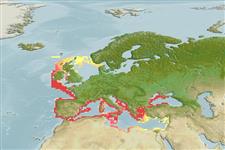Common names from other countries
Classification / Names / Names
Namen | Synonyme | Catalog of Fishes (gen., sp.) | ITIS | CoL | WoRMS
Environment: milieu / climate zone / depth range / distribution range
Ökologie
; tiefenbereich 125 - 200 m (Ref. 2754). Tropical, preferred 16°C (Ref. 107945); 61°N - 30°N, 11°W - 36°E
Northeast Atlantic, the Mediterranean and the Black Sea. Introduced to the Arctic, Indian and Pacific Oceans.
Length at first maturity / Size / Gewicht / Alter
Maturity: Lm ? range ? - ? cm Max length : 16.5 cm SHL Männchen/unbestimmt; (Ref. 109255)
The shell lacks radiating ridges containing three small teeth below the beak. The exterior is often bluish black with the interior portion being dull blue (Ref. 310).
Found in warmer waters (Ref. 95344). Occurs in quiet waters and lives lower in the intertidal zone attached to rock substrates (Refs. 310, 125090). Inhabits muddy and sandy bottoms (Ref. 125090). Smaller individuals move to the outer edge of the colony (Ref. 310). Feeds on a variety of phyto- and zooplankton (Ref. 112108).
Life cycle and mating behavior
Geschlechtsreife | Fortpflanzung | Ablaichen | Eier | Fecundity | Larven
Members of the class Bivalvia are mostly gonochoric, some are protandric hermaphrodites. Life cycle: Embryos develop into free-swimming trocophore larvae, succeeded by the bivalve veliger, resembling a miniature clam.
Demir, M. 2003. (Ref. 2754)
IUCN Rote Liste Status (Ref. 130435)
CITES Status (Ref. 108899)
Not Evaluated
Not Evaluated
Nutzung durch Menschen
Fischereien: kommerziell
FAO - Aquakultur: production, Artbeschreibung; Fischereien: landings, Artbeschreibung | FishSource | Sea Around Us
Tools
Internet Quellen
Estimates based on models
Preferred temperature
(Ref.
115969): 5.5 - 18, mean 11 (based on 176 cells).
Widerstandsfähigkeit
hoch, Verdopplung der Population dauert weniger als 15 Monate. (K=0.1-1.82).
Prior r = 0.50, 95% CL = 0.33 - 0.75, Based on 2 data-limited stock assessments.
Verwundbarkeit
Low vulnerability (10 of 100).
